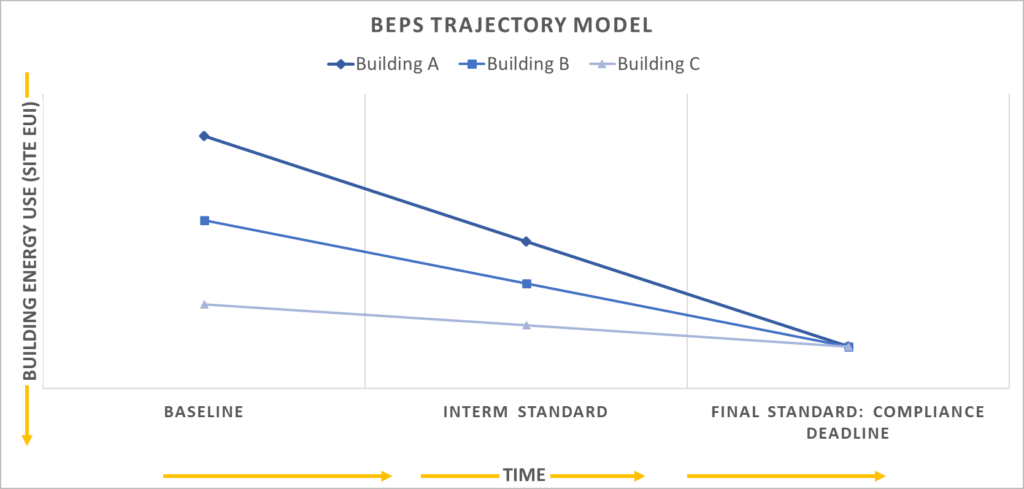Montgomery County and the State adopted complementary standards
On April 19, the Montgomery County Council unanimously approved the County’s Building Energy Performance Standard (BEPS) law. On April 9, Maryland’s Climate Solutions Now Act became law; it includes a very different BEPS with a similar goal of building-related carbon reduction.
Both new laws are types of Building Performance Standards (BPS) and should be celebrated as the largest, most concrete, and ambitious steps either jurisdiction has taken toward reducing climate impact and achieving climate commitments. The sweeping Maryland law addresses buildings and many other aspects of Maryland’s economy. It commits the State to reducing greenhouse gas emissions by 60% below 2006 levels by 2031 (up from the 40% reduction already in law). It also sets a goal of achieving carbon neutrality by 2045.
The two new BPS are the latest additions to a growing wave of state and local BPS adoptions, many of which IMT is supporting as part of the National Building Performance Standards Coalition. As will be explained below, IMT believes some specific strategies are needed to ensure policies are both effective and equitable.
How the new BEPS work
Both the State and County BEPS will be applied to large commercial, public, and multifamily buildings. The Maryland BEPS will cover buildings 35,000 square feet and larger. The Montgomery County BEPS will start with larger buildings and rapidly phase down to buildings as small as 25,000 square feet. Both laws also include benchmarking and transparency requirements which take effect prior to BEPS requirements, such that each building will be required to benchmark and then a few years later it will be required to perform at or better than the applicable BEPS.
Advised by new advisory bodies created in their new laws, the State and County will now develop regulations including establishing the numerical performance standards.
The two BEPS complement each other
The Montgomery County and Maryland BEPS will work together to require buildings to employ both electrification and energy efficiency. This is because the county policy addresses site energy use intensity, a common metric for efficiency, and the State policy sets maximum levels of direct greenhouse gas emissions attributable to each building from onsite and district thermal emissions. Starting in 2030, Maryland buildings’ direct emissions will be required to be at or below standards set by the Maryland Department of Environment and, starting in 2040, Maryland buildings will be required to have net zero direct emissions. Since a building’s grid electricity consumption will not count against the Maryland direct emissions limits, the state law will push buildings to electrify. The two laws will complement the decarbonization of Maryland’s electric grid, which is driven by market forces (including the falling cost of wind and solar) and by the State’s renewable portfolio standard.
IMT’s analysis and recommendations
There are important differences between the two laws. Montgomery County’s EUI requirement will strongly disincentivize building owners from pursuing inefficient electrification such as outdated electric resistance heating – an inefficient technology that is over a century old. Compared with modern heat pumps, electric resistance heating uses twice, three time, or more electricity per unit of heat delivered, placing a huge burden on the electric grid and on whomever pays electric bills.
Outside of Montgomery County, the Maryland BEPS’s narrow focus on direct emissions could lead building owners, especially those whose tenants pay the building’s electric bills, to install electric resistance heat instead of heat pumps. Owners would do this to reduce the amount they invest in equipment and installation because electric resistance heat is relatively cheap and easy to install. But, because of its inefficiency, electric resistance heat is not a climate solution and can greatly increase utility bills, creating energy burden and housing affordability problems, especially for low-income tenants. Electric resistance heat could also increase peak demand for electricity, potentially necessitate billions of dollars of otherwise unneeded investment in the electrical grid and increase electricity prices for all Marylanders. Statewide safeguards should be put in place administratively or through additional legislation in 2023 to protect against these unintended, expensive, and inequitable outcomes. Similarly, the State should act to provide certainty to building owners by 2024 about the exact level of performance that will be required of their buildings in 2030. Doing so will enable owners to plan and execute long-term, long lived investments like installing heat pumps. The sooner owners have certainty, the sooner they are likely to invest.
To address this issue, Montgomery County’s policy includes a trajectory approach (see illustration below), originated by IMT. This approach uses a combination of long- and short-term performance standards to provide building owners with regulatory certainty and appropriate flexibility to accommodate typical capital planning cycles, while still pushing owners to improve their properties at the earliest opportunity. My colleague, Zachary Hart, further explains the trajectory approach in his earlier blog post and this approach is used in IMT’s Model BPS Ordinance. IMT recommends that all BPS implement similar strategies to create clarity and certainty for building owners.

Maryland and Montgomery County should closely coordinate to harmonize their BEPS and minimize the reporting and compliance burden on Maryland building owners. To this end, Maryland should commit to relying on the federal ENERGY STAR system as its reporting and compliance platform, which Montgomery County has already done. In fact, to better leverage the counties’ existing building departments and relationships with their local building owners, the State should consider allowing counties, including Montgomery County, to opt to implement and enforce the State BEPS with the State providing annual payments to cover the counties’ implementation costs. California’s Assembly Bill 802 benchmarking requirement provides a well-proven model for this local-state partnership.
Advancing Equity
Both laws leave many critical decisions to rulemaking, and it is essential that these decisions benefit marginalized and disinvested communities. To secure success, both jurisdictions should
- Defer to these communities in designing and implementing their policies and programs
- Ensure that these communities are well and authentically represented on advisory bodies
- Work with utilities to provide ample financial and technical resources to help buildings serving disinvested communities to improve their performance, benefit their occupants, and comply with the BEPS
- Invest in workforce development focused on these communities to provide the many workers needed to renovate and operate buildings to decarbonize buildings as required by the BEPS
IMT’s community engagement team, is currently developing a framework that these, and other, jurisdictions can follow to improve equity. What’s critical is that both Montgomery County and Maryland see equity as a priority, and give sufficient time and resources to ensure that the all affected community members have a seat at the table in both policy design and implementation.
To learn more about building performance standards, visit imt.org/bps.
To learn more about Montgomery County’s BEPS and access the full legislative packet, visit the County’s website.
The Building Innovation Hub, based in Washington DC, has resources to help building owners and operators improve building performance, which will assist in meeting performance standards.
